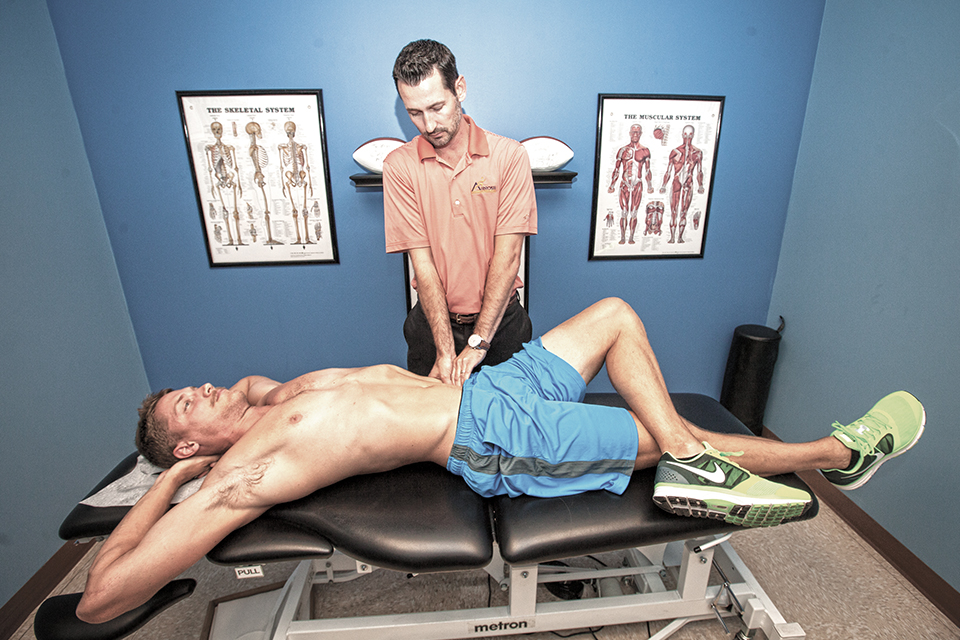Keeping Austin Moving

In the August issue of AFM, I wrote an article naming five things to look for when choosing the right provider for your injury. In that article, there was no particular mention of specific treatments or providers, just simply guidelines to help steer you in the right direction. After reading “The 5 Indicators,” some might be inclined to ask, “Is there anyone out there who meets these criteria?” The answer is, yes.
Let me introduce you to Airrosti. Many of you may have at least heard of Airrosti around Austin but don’t know what it is. When I ask patients what they know, they usually say something like, “I heard it hurts but it works.”
Airrosti is an acronym standing for “applied integration for the rapid recovery of soft tissue injuries.” Thank goodness for acronyms, right? The main focus here is “rapid recovery.” Of the more than 130 Airrosti Certified Providers (ACPs) stretching from Texas to Oklahoma, Virginia, Ohio, Illinois, and soon to include Washington, each one averages three treatments to resolve soft tissue injuries. It doesn’t matter if you see a provider in Austin or while on vacation in Chicago; your treatment plan, to completion, should be near three treatments. Every provider is focused on these quality results. In fact, Airrosti practioners average three treatments 88 percent of the time. As I mentioned in my last article, there is no treatment that is 100 percent effective for 100 percent of the population, but these are unique results.
So, what is Airrosti? How does it work? Airrosti is a company that extensively trains and employs doctors of chiropractic to deliver outcome and evidence-based musculoskeletal care. ACPs must make it through a rigorous interview process before being hired and trained. Once trained, providers are able to access and diagnose the root cause of pain to deliver a highly specific soft tissue, manual therapy to the correct affected areas. This manual therapy focuses mostly on fascial tissue, ligaments, and tendons. There are numerous studies and evidence on manual therapy and its effectiveness with soft tissue injuries. Airrosti providers use a safe, effective, and evidence-based form of specific manual therapy. Outcome data is taken directly from the patients and processed by third-party statistical analysis companies, and insurance companies love this part: Airrosti practioners can tell you how many surgeries have been prevented, how many patients are referred for imaging, what the average is for a certain condition (e.g., carpal tunnel or plantar fasciitis), and so on.
How is Airrosti different from other manual therapies (ART, Graston, Rolfing, etc.)? The biggest difference is what I have described above: Airrosti employs and trains its providers, who are vetted through an interview process. Each provider’s results are measured to ensure quality. Each appointment lasts one hour and is one-on-one. During each treatment, the patient is evaluated, tested, treated, and taken through active rehabilitation. This approach helps reduce unnecessary imaging, medication, and surgeries. Combined with a three-visit average, this results in major cost savings for the patient and the health care system.
In comparison, other manual therapies are set up much differently. They are effective; however, none of them measure results from everyone they certify. Individuals seeking training in these therapies—which range from athletic trainers and massage therapists to chiropractors and physical therapists—sign up and pay for the seminars. They are not employed under one umbrella, so quality control is absent.
Here is an example: You may go to a physical therapist who is great at ART and go to a chiropractor who is subpar at it. For the most part, these treatments are not outcome based. There is usually a set “treatment plan” that is followed regardless of outcome. Again, these other therapies are good techniques if applied correctly. I am only pointing out the difference between what Airrosti does versus these other methods.
Airrosti has taken a highly specific form of manual therapy, developed here in Austin, and applied it to a treatment model that is implemented by highly motivated, passionate, and results-oriented providers. The focus on results and quality of care across the Airrosti provider network is unique. The company's mission is to positively affect the lives of patients and relieve them from pain. Statistics show 99.7 percent of Airrosti patients would recommend this treatment to their friends and family. This number is higher than the 88 percent of the patients whose issues are resolved in three visits. Therefore, even patients who didn’t see resolution were impressed by the process and the quality of care.
Austin is consistently ranked as one of the fittest cities in America. With that distinction, Austinites may find themselves with an increase in musculoskeletal injuries. Airrosti Rehab Centers’ providers take ample time to evaluate, test, treat, and rehab soft tissue injuries. Treament occurs while you stay active. In most cases, there is no need to completely stop what you are doing. “Keep Austin Moving”? No problem!






